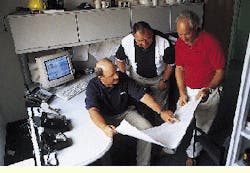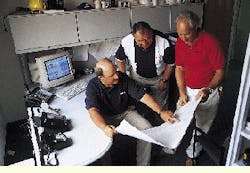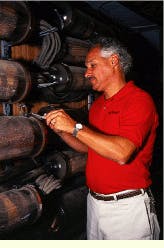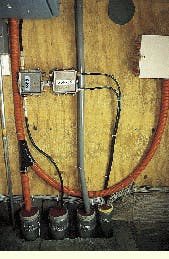A state-of-the-art telecommunications and data-communications network is a powerful recruiting and administrative tool that also creates a sense of community in this far-flung urban campus.
Daniel E. Malone, New York University
Not so many years ago, students arrived at college with a suitcase, a manual typewriter and, maybe, a clock-radio. If they wanted to use a computer or make a telephone call, they packed themselves off to either the campus computer lab or the pay phone down the hall.
Today, most students bring enough electronic gear--including powerful, Internet access-equipped personal computers--to run a small business. And institutions of higher education are using their networks as a recruiting tool, seeking to attract top students by offering them access to campus and worldwide data resources, plus a personal phone number.
During the summer of 1996, New York University (NYU--New York, NY) completed a $2 million upgrade of its telephone, data and cable-TV infrastructures at three dormitories housing a total of 1700 students. This upgrade was part of a long-term program to provide each dorm`s bedroom with in-room telephone and data services and a cable-TV outlet. In-room telephone service includes voicemail.
A duplex, wall-mounted voice/data jack is the gateway to the campus`s telephone and high-speed data services. To facilitate accounting, each dorm`s bedroom has a unique five-digit campus telephone extension.
Students living in dormitories now represent about 30% of the 17,000 campus telephones served by NYU`s AT&T Definity G2.2 and G3R telephone switches. Most of the telephones are used by administration in the day-to-day operation of the university, including ongoing research funded by grants. Campus-wide, NYU`s private telephone and data network links more than 100 university buildings. Based on the quantity of analog and digital trunk lines and special circuits serving the university, NYU is considered one of the largest customers of regional Bell operating company nynex.
In all three of the dormitories in the 1996 cabling project, brand-new copper and optical-fiber cable systems, both underground and intrabuilding, were part of the upgrade. Here we will take a detailed look at the riser installation in one of the dormitories, Brittany Hall, which was handled by New York-based integration firm ExtraNet Inc.
Why the upgrade?
While Manhattan`s Washington Square Park neighborhood in Greenwich Village comprises the bulk of NYU facilities, academic buildings and housing extend over a much wider area. For example, the university`s medical and dental schools are located approximately 26 blocks north and five blocks east at 1st Avenue and 30th Street. But these schools are still part of NYU`s private communications network, thanks to a 15,000-foot optical-fiber connection to the Washington Square campus.
University administrators recognize that a feeling of community is important to maintain spirit and a greater sense of security. Allowing students access to others in the student body through five-digit dialing and voicemail contributes to building and maintaining a campuswide community. Teachers, administrators and other employees are also available via five-digit dialing, voicemail and e-mail.
NYU`s private communications network also provides access to university data resources and the Internet, supporting the educational process for students and research by faculty members.
Finally, and equally important, a state-of-the-art telecommunications and data-communications system supports recruiting in an increasingly competitive academic environment.
One key to a successful networking project is a thorough knowledge of the buildings being wired, and another is understanding of the applications to be supported by the network. Still others include support from central administration, a well-written plan and timetable, and selecting a proven vendor.
While on the surface these points may appear to be straightforward, in fact, many institutions do not assign the task of a network buildout a sufficiently high priority to ensure good planning. The result: a substandard system that sooner or later fails to deliver the performance required.
Brittany Hall, the 17-story, 600-student residence at 55 East 10th Street, exemplifies the many challenges that can arise when making a major service upgrade. Built at the turn of the century, Brittany was a hotel for many years before being acquired by NYU. Since 1965, nynex has provided local telephone service to Brittany.
Working with communications consultant Robert Silber, who is a bicsi registered communications distribution designer (rcdd), NYU opted for a complete rebuild in Brittany, including new, adequately sized, stacked telecommunications closets served by intermediate crossconnects and a new building distribution frame in the basement.
Specifications were written to provide the flexibility necessary to grow the network`s capabilities without trashing what is in place. For example, all student data ports are designed to interface with the university`s 10-megabit-per-second Ethernet local area network (LAN). Almost nonexistent in the mid-1980s, the campus-wide LAN is growing steadily as more buildings are being added to it each summer. It is now capable of supporting Asynchronous Transfer Mode and Fiber Distributed Data Interface data rates.
Similarly, 50% spare conduit and cable capacity is designed in as insurance against future needs. That`s because going back into a system to add new conduit or cable is much more expensive than investing in spare plant at the outset. This is especially true given rapid changes in technology and the introduction of new LAN-based services.
At NYU, adds, moves and changes to building wiring supporting telecommunications, data-communications and video technology requirements are a way of life. But thanks to competition in this industry, dealing with a single contractor or vendor is no longer a way of life. Over the past 11 years, NYU has developed a fairly straightforward method of selecting contractors; applicants make its short list by demonstrating their capabilities on smaller projects.
The process begins after specifications are written and agreed upon among university telecommunications officials. The NYU telecommunications department, together with the consultant, Robert Silber, then puts the projects out for bid. A bidders` conference includes individual walk-throughs of the job, where candidates can ask questions. Candidates are then given one month to provide a complete bid.
Bidders are encouraged to revisit the site prior to the deadline to verify field conditions. Suggestions that improve performance or that save money while maintaining performance specifications are welcomed.
While competitive bidding is part of the contractor selection process, NYU reserves the right to select a contractor that has demonstrated outstanding performance rather than the one that submitted the lowest bid. The rationale for this is simply stated: An institution such as NYU cannot compromise on quality and reliability for such an important part of the campus network infrastructure.
For dormitory projects, the most logical time to make upgrades is during summer recess. A tight turnaround time is therefore essential to accommodate the return of the students in late August. ExtraNet Inc. won the Brittany Hall project, the most difficult of the 1996 summer season, based on a competitive bid plus the capabilities it had demonstrated on earlier NYU projects.
The project was considered the most difficult because Brittany Hall is off-campus, several blocks away from the main concentration of university buildings. Streets had to be excavated and new 4-inch conduits installed to run the new cable to Brittany.
The installation
Brittany Hall is located less than 1000 feet from NYU`s private communications network, as the crow flies. But, to make the connection, NYU`s communications contractor had to run 2700 feet of 1500-pair copper cable, as well as 36 strands of multimode and 24 strands of singlemode, gel-filled, loose-tube optical fiber, through underground conduit that follows the streets of New York.
Due to space restrictions, the copper run required two conduits and seven splice joints. The optical-fiber runs were installed splice-free. In compliance with fire regulations, a transition from gel-filled cable to Lucent Technologies` (formerly AT&T) Accumax riser cable was made at the telecommunications service entrance facility.
Fortunately, it was possible to serve all 17 floors from only nine newly constructed telecommunications closets, achieving significant economies without compromising performance. AT&T Category 5-rated modular crossconnect patch panels capable of serving multiple floors were first installed. Then, vertical riser cabling was run through sleeves connecting the floors. Taking care not to impart stress or subject the cable to pressure or bending, installation crews both lowered the cable from the top of the building and pulled it from the basement to patch panels in the closets. AT&T Category 5-rated, 4-pair UTP cable was run from the jack in each dorm bedroom to the service closet.
Following Lucent recommendations, NYU standardized on the optical characteristics of riser cable. While there is a temptation to save costs by tailoring optical characteristics to the portion of the route in which riser cable is utilized, over the long run this practice can cost money, especially during upgrades. Having cable with differing characteristics can also increase the chances that the wrong cable will be installed at a particular site, and it can complicate ongoing maintenance.
All aspects of the cabling project were governed by wiring and building standards ansi/tia/eia-568a and ansi/eia/tia-569, issued jointly by the American National Standards Institute (New York, NY), the Telecommunications Industry Association and the Electronic Industries Association (both of Arlington, VA).
Horizontal runs in the basement were supported by a new trapeze system. Optical riser cable was protected by innerduct and supported per manufacturer`s recommendations with its own hanger system toggle-bolted into building walls and patch panels. Four-inch sleeves were used between floors, and extra sleeves were installed to accommodate future expansion. Sleeves were fitted with couplers to protect the innerduct and other cable. They were then firestopped after the installation was completed.
At the Category 5-rated modular data-communications patch panels in the telecommunications closets, a transition was installed to link optical fiber to Category 5 copper. Together with the telephone lines, these data lines were routed through 13,000 feet of newly installed metal wire molding.
It was not acceptable to NYU for its contractor to take shortcuts in testing the optical fiber, or in testing and providing documentation for all the Category 5, 4-pair UTP cable. Each step of the installation process, therefore, was thoroughly tested and documented. Daily walk-throughs by university personnel were conducted to monitor not only progress, but to ensure that the physical installation complied with relevant standards. All NYU cabling projects are designed, installed, certified and approved under the AT&T/Lucent Technologies systimax Structured Cabling Systems program.
Concurrent with the installation, the cabling diagram was developed to support future maintenance, growth and troubleshooting. An internally developed program can be used by technicians at any NYU site to access any telephone or data jack in the university--by building, floor, phone number, data port or through the switching centers. But, the system works correctly only if wiring diagrams and the supporting databases are accurate and up-to-date.
Of course, the final proof of any installation comes when it is turned over to the end-user. NYU students demand a lot, and, given the current cost of higher education, a fully functional communications system is a necessity for academic institutions. So, the first and best test of any system is made shortly after the student`s arrival on campus, when that all-important call is made: "Hi Mom, I`m here!" (Today, however, it`s more likely to be an e-mail message over the Internet.)
But regardless of the extent to which students access campus and global data resources, the new network at New York University passed all tests.
ExtraNet`s manager of operations Peter Heller (right), consultant Robert Silber (center) and New York University assistant director of telecommunications Daniel Malone (left) review plans for the Brittany Hall cabling project.
Peter Heller works in the NYU cable vault, where all campus trunk lines converge.
In the telecommunications closet in Brittany Hall, riser cable passes to an upper floor through firestopped sleeves.
Network management software on Daniel Malone`s desktop computer shows street maps of the NYU campus, building plans and information on connections to individual dormitory rooms. Shown is information for a room in Brittany Hall.
Daniel E. Malone is assistant director of telecommunications at New York University (New York, NY).




